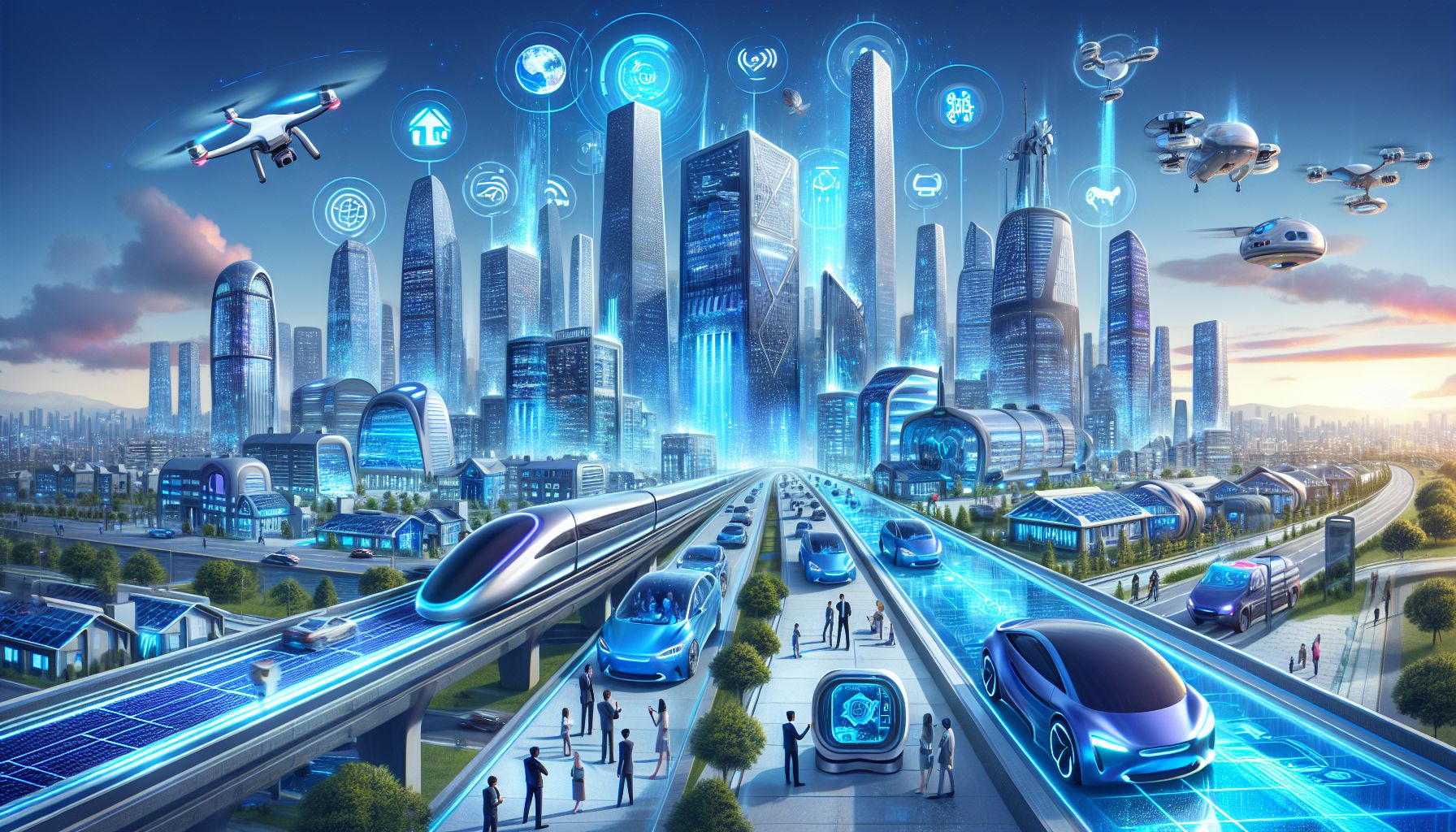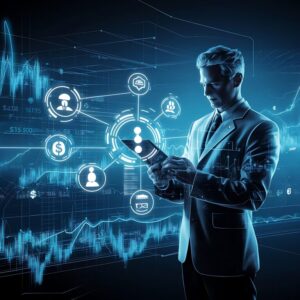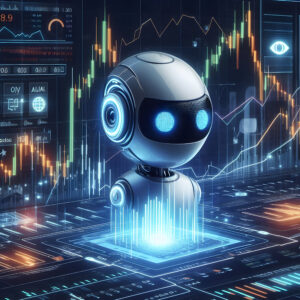20 Incredible Future Technologies That Will Redefine Our World by 2040
The future is filled with promise, and future technologies by 2040 are poised for remarkable transformation. Multiple future technologies are set to revolutionize our lives, reshaping everything from healthcare to how we communicate. As I delve into the advancements that will define our future, I can’t help but marvel at the potential each technology holds. From gene editing that will redefine what it means to be human, to the advent of artificial wombs, the possibilities are truly astonishing. Let’s explore these groundbreaking future technologies that are not just on the horizon but are rapidly advancing toward reality.
We strongly recommend that you check out our guide on how to take advantage of AI in today’s passive income economy.
Table of Contents
1. Gene Editing
One of the most exciting developments in biotechnology is gene editing, particularly through a method known as CRISPR. This technology functions like molecular scissors, enabling scientists to make precise modifications to the DNA of organisms. Imagine being able to correct genetic defects in embryos, paving the way for healthier generations. This capability is not merely theoretical; it’s already being applied in animal models, creating pathways for treating severe human genetic disorders like cystic fibrosis and muscular dystrophy. As we look ahead, gene editing promises to not only eliminate hereditary diseases but also allow parents to choose specific traits for their children, such as height and eye color.
The implications of these choices are profound and raise important ethical questions. If we can design our offspring, what does it mean for the future of humanity? While the potential benefits of personalized medicine are exciting, where do we draw the line? This technology could revolutionize healthcare by tailoring treatments to an individual’s genetic profile, making them more effective and minimizing side effects. Moreover, in agriculture, gene editing could lead to the development of crops that are not only more nutritious but also more resilient against environmental challenges. In a world facing rapid population growth and changing climate conditions, the promise of gene editing could be key to ensuring food security.
2. Artificial Wombs
Another remarkable advancement is the concept of artificial wombs, also known as EXOWS. These pioneering devices aim to create environments that closely mimic a natural womb, significantly enhancing neonatal care for premature infants. By utilizing bio-bags filled with a fluid similar to amniotic fluid, artificial wombs can provide the necessary nutrients and oxygen while removing waste, replicating the conditions vital for healthy development. As a parent, the idea that we can enhance the chances of survival and healthy growth for premature babies is incredibly heartwarming.
However, the potential applications extend far beyond neonatal care. For individuals who are unable to carry a pregnancy, artificial wombs offer new hope for couples facing infertility, single individuals, and same-sex couples desiring biological children. Imagine being able to gestate a baby in an environment specifically designed for its growth and safety. Furthermore, as humanity embarks on long-term space missions, the ability to safely gestate offspring in space environments becomes critical. The use of artificial wombs could allow for human reproduction in space, overcoming the complexities traditional pregnancy faces in microgravity.
3. Asteroid and Moon Mining
By 2040, we might witness the dawn of a new era in commercial space ventures through asteroid and moon mining. The extraction of metals and minerals from these celestial bodies is not just a fantasy; it is rapidly becoming a reality. This new frontier holds the promise of driving significant innovation and wealth creation in the coming decades. While it may start as a small fraction of the global commodities market, the potential for growth is immense.
The excitement surrounding moon and asteroid mining could create a ripple effect in the stock market, potentially propelling a savvy business tycoon to become the world’s first trillionaire. As we look toward the future, the technologies and infrastructure required for space resource utilization are advancing at an unprecedented pace. Imagine a world where we can tap into resources beyond our planet, alleviating some of the pressures we face on Earth. This groundbreaking development could transform our economy and create entirely new industries focused on space exploration and resource extraction.
4. Fusion Power
Fusion power, often described as the quest for a mini sun on Earth, stands as one of the most promising frontiers in energy research. The process involves fusing two light atomic nuclei to form a heavier nucleus, releasing an incredible amount of energy in the process. As I think about the energy challenges our world faces, achieving fusion power could represent a sustainable solution to our energy needs. The primary focus of fusion research is the reaction between deuterium and tritium, two hydrogen isotopes, which yields helium and significant energy.
Creating the extreme temperatures and pressures needed for fusion is no small feat, but advancements in high-temperature superconducting magnets are making this dream more attainable. These magnets are crucial in fusion reactors, helping to stabilize the hot plasma necessary for the reaction to occur. Fusion power has the potential to provide nearly limitless clean energy, generating no greenhouse gas emissions and producing only minimal radioactive waste. This makes it an appealing alternative to fossil fuels and a valuable complement to renewable energy sources like solar and wind.
5. Personalized Virtual Assistants
Imagine a world where lifelike virtual assistants become part of our everyday lives by 2040. These advanced digital companions could be tailored to each individual’s preferences, providing a highly interactive and personalized experience. With technology evolving rapidly, I envision these assistants built on language models far beyond what we currently have, equipped to understand and respond to almost any query.
These virtual assistants would go beyond simple commands, actively predicting our needs and making suggestions throughout the day. Picture a scenario where instead of searching online, your assistant knows you so well that it anticipates your questions and offers solutions before you even ask. Furthermore, these assistants could manifest as 3D virtual characters or holograms, making them feel even more lifelike. The customization options would allow users to tweak their assistants’ personalities, appearances, and abilities, creating a truly unique companion for the digital age.
6. Carbon Nanotubes
After decades of research, we are on the brink of a breakthrough with carbon nanotubes, which are composed of carbon atoms arranged in a cylindrical nanostructure. These nanotubes can potentially reach lengths of thousands of miles and boast strength hundreds of times greater than steel. The possibilities for their applications are vast, ranging from lightweight composites for transportation to innovative materials for electronics and even radiation shielding.
As I consider the implications of this technology, I can’t help but marvel at its potential to transform various industries. Imagine clothing that is not only water-resistant but also capable of providing protection, or lightweight structures in aviation that can improve fuel efficiency. Some futurists even speculate that carbon nanotubes could make the idea of a space elevator feasible, opening up new avenues for space travel and exploration.
7. Quantum Internet
The concept of a Quantum Internet is set to revolutionize how we communicate. Utilizing quantum signals instead of traditional radio waves, this technology promises unparalleled security for data transmission. With quantum encryption, the information sent would be virtually immune to hacking, offering a level of security that is currently unimaginable. By 2040, I envision a world where individuals can use personal computers to access and transmit quantum-encrypted information through a cloud-based quantum computer.
The groundwork for this revolutionary network is already being laid, with initiatives from the U.S. Department of Energy unveiling plans for a national Quantum Internet. As we approach 2030, we may see the emergence of prototypes that herald a new era of secure communication. This development will mark a significant milestone in integrating quantum technology into our everyday lives, promising to transform personal and professional communication.
8. Zeta Scale Supercomputers
Looking ahead, the first Zeta-scale supercomputer could become operational by 2040, marking an unprecedented leap in computational power. These supercomputers would be capable of performing one million times more calculations than the fastest machines of the early 2020s. With their ability to handle extremely large volumes of data, Zeta-scale supercomputers could open new frontiers in research and data analysis.
As I envision this future, I see these supercomputers operating on a decentralized model, composed of millions of less powerful components working together in harmony. This collective computing power will enable breakthroughs in fields ranging from climate modeling to complex simulations in healthcare and beyond. The capabilities of Zeta-scale supercomputers could empower researchers and innovators to solve some of the world’s most pressing challenges, ushering in a new era of discovery and advancement.
9. Military Technology
The landscape of military technology is also poised for dramatic changes, particularly with the rise of hypersonic missiles. Unlike traditional cruise missiles, which travel at speeds of 500 to 600 mph, hypersonic missiles can exceed Mach 5, traveling at more than seven times the speed of sound. This remarkable speed presents significant challenges for existing defense systems, as intercepting such fast-moving projectiles is virtually impossible with conventional measures.
The development of hypersonic technology is already underway, with nations like China successfully testing nuclear-capable missiles. As more countries invest in this technology, its use is likely to become commonplace in military arsenals, reshaping global security dynamics. The speed and evasion capabilities of hypersonic missiles will force a reevaluation of existing defense strategies and could lead to a renewed arms race as nations strive to maintain a strategic edge.
10. The Rise of Service Robots
By the mid-2030s, we may witness the global population of service robots reach an astonishing one billion. These robots can be categorized into personal and professional types, with personal robots designed for individual use. I envision a future where household robots, such as vacuum cleaners and lawnmowers, become standard, providing convenience and assistance in our daily lives.
On the professional front, robots will play a critical role in various industries, from healthcare to security. Medical robots performing surgeries and automated delivery robots transforming logistics are just a few examples of how these innovations will enhance efficiency and safety. The rapid growth of service robots is facilitated by advancements in machine learning, cloud computing, and sensor technology, making them more intelligent and versatile.
11. CRISPR-Based Diagnostics
Beyond gene editing for therapeutic purposes, CRISPR technology is set to transform diagnostic capabilities as well. The development of CRISPR-based diagnostic tools promises to deliver rapid, accurate, and cost-effective testing for various diseases, including infectious diseases and cancers. As I imagine a future where these tools are readily available, I see a world in which diseases are diagnosed at their earliest stages, improving treatment outcomes significantly.
The impact of CRISPR-based diagnostics will extend beyond traditional healthcare settings. The ability to perform rapid tests in community settings and remote areas could revolutionize global health, particularly in under-resourced regions. This technology could facilitate early detection and intervention, ultimately leading to better health outcomes and quality of life for individuals worldwide.
12. Augmented Reality and Virtual Reality
The convergence of augmented reality (AR) and virtual reality (VR) is poised to reshape our interaction with the world. By 2040, we may find ourselves navigating a landscape where these technologies are seamlessly integrated into our daily lives. As I envision this future, I see AR enhancing our understanding of our surroundings by overlaying digital information onto the physical world. Imagine using AR glasses to receive real-time data about objects and people in your environment, enriching everyday experiences.
Meanwhile, VR will continue to expand its applications beyond gaming into areas such as education, training, and therapy. Virtual environments will provide immersive experiences for learning, allowing users to practice skills and concepts in realistic settings. As these technologies evolve, they will enable new forms of interaction, communication, and creativity, fundamentally transforming how we perceive and engage with the world.
13. Autonomous Vehicles
The automotive landscape is set to undergo a seismic shift with the advent of autonomous vehicles. By 2040, fully autonomous cars, trucks, and even buses may dominate our roads. As I contemplate the implications of this shift, I envision a future where commuting becomes safer and more efficient, eliminating human error from the driving equation.
The convenience of autonomous vehicles will also open up new opportunities for mobility, providing access to transportation for individuals who are currently unable to drive. The societal benefits of widespread adoption of autonomous vehicles extend beyond convenience; they could lead to reduced traffic congestion, lower emissions, and a more efficient transportation system overall.
14. Brain-Computer Interfaces
The development of brain-computer interfaces (BCIs) has the potential to revolutionize how we communicate and interact with technology. By 2040, BCIs could allow individuals to control devices using only their thoughts, bridging the gap between human cognition and digital systems. As I think about the implications of this technology, I see a world where individuals with disabilities can regain independence and improve their quality of life.
The applications of BCIs extend beyond accessibility. Imagine a future where professionals can enhance their productivity by seamlessly interacting with their digital environments through thought alone. This technology could enable new forms of communication, learning, and creativity, fundamentally altering how we experience the world.
15. Space Colonization
As we venture into the cosmos, the concept of space colonization becomes increasingly feasible. By 2040, we may witness the establishment of permanent human settlements on the Moon and Mars, paving the way for a new chapter in human history. I envision a future where the exploration of space is not limited to short missions, but rather encompasses thriving communities where humans can live, work, and thrive beyond Earth.
The challenges of space colonization are immense, ranging from life support systems to sustainable agriculture in extraterrestrial environments. However, advancements in technology will pave the way for innovative solutions, enabling humanity to adapt and thrive in these new frontiers. The prospect of living on other celestial bodies is no longer just a dream; it is becoming a tangible reality.
16. Renewable Energy Innovations
The transition to renewable energy sources is crucial for combatting climate change, and by 2040, we are likely to see remarkable innovations in this field. Technologies such as advanced solar panels, wind turbines, and energy storage systems will significantly enhance our capacity to harness renewable energy. I foresee a world where renewable energy becomes the dominant source of power, reducing our dependence on fossil fuels and minimizing environmental impact.
Moreover, the integration of renewable energy into smart grids will allow for more efficient energy distribution and consumption. This interconnected system will enable consumers to manage their energy use actively, optimizing consumption based on real-time data. The impact of these advancements will extend beyond individual households, transforming cities into hubs of sustainability and resilience.
17. 3D Printing Advancements
3D printing technology has already begun to reshape manufacturing and production processes, and by 2040, we can expect to see even more advanced applications. This technology enables the creation of complex structures using a variety of materials, from metals to biological tissues. As I think about the possibilities, I envision a future where on-demand manufacturing becomes the norm, reducing waste and inefficiency.
In fields such as healthcare, 3D printing holds the potential to revolutionize prosthetics and organ transplants. Imagine being able to print a custom prosthetic limb that perfectly fits an individual’s unique anatomy, drastically improving comfort and function. The continued evolution of 3D printing will pave the way for more sustainable practices and transformative applications across various industries.
18. Advanced Cybersecurity
As our reliance on technology increases, so do the threats to our digital security. By 2040, advanced cybersecurity measures will be critical in safeguarding our personal and professional data. The rise of AI-powered security systems will enable real-time threat detection and response, significantly enhancing our ability to combat cyber threats. As I consider the implications of this technology, I see a future where individuals and organizations can navigate the digital landscape with greater confidence.
Moreover, as quantum computing becomes a reality, traditional encryption methods will need to evolve to withstand new challenges. The development of quantum-resistant algorithms will be essential for ensuring data security in this new era of technology. The ongoing advancement of cybersecurity measures will be vital in maintaining trust and safety in our increasingly interconnected world.
19. Sustainable Urban Design
As urbanization continues to accelerate, the need for sustainable urban design becomes increasingly critical. By 2040, we may witness the emergence of smart cities that prioritize sustainability, efficiency, and quality of life. Imagine urban environments where green spaces, efficient public transportation, and smart infrastructure seamlessly integrate to create livable spaces.
The adoption of sustainable practices in urban design will enhance air quality, reduce energy consumption, and improve residents’ overall well-being. I envision a future where cities not only accommodate growing populations but also thrive as vibrant, eco-friendly spaces that foster community and innovation.
20. The Internet of Things (IoT)
The Internet of Things (IoT) is set to become a defining feature of our everyday lives by 2040. With billions of connected devices, our homes, cities, and workplaces will be more intelligent and responsive than ever before. I see a world where our appliances, vehicles, and infrastructure communicate seamlessly, optimizing our daily experiences.
Imagine waking up in a smart home that adjusts the temperature, lighting, and even your morning coffee based on your preferences. The potential applications of IoT extend far beyond convenience; they can significantly enhance energy efficiency, reduce waste, and improve overall quality of life. As this technology matures, it will become an integral part of how we live, work, and interact with our environment.
Conclusion
The advancements in technology set to unfold by 2040 are nothing short of awe-inspiring. Each innovation presents unique opportunities and challenges, reshaping our society, economy, and environment. As we stand on the cusp of this new era, it is essential to navigate these changes thoughtfully, considering the ethical implications and societal impacts. The future is bright, filled with potential for a better world, and I can’t wait to see how these incredible technologies will transform our lives in the years to come.

We strongly recommend that you check out our guide on how to take advantage of AI in today’s passive income economy.




